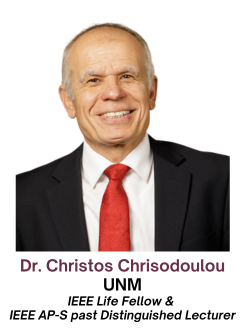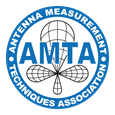2025 Regional Meeting - Abstracts & Speakers

Host for the 47th Annual Meeting and Symposium of the Antenna Measurement Techniques Association (AMTA)
Save the Date for the 47th Annual Meeting and Symposium of the Antenna Measurement Techniques Association (AMTA)! To be held at the Westin La Paloma Resort & Spa in Tucson, AZ, USA from November 2 – November 7, 2025.
Antennas, Machine Learning, and Emerging Space Technologies
As the demand for high-frequency satellite communications continues to rise, innovative solutions in propagation modeling, antenna design, and intelligent space systems are becoming increasingly critical. This presentation will delve into cutting-edge advancements in W/V band propagation modeling, leveraging machine learning to enhance accuracy and adaptability in future satellite networks.
We will explore the development of W/V band antennas, their role in satellite communications, and hypersonics. Additionally, the talk will highlight the application of machine learning in CubeSat detection and classification, improving situational awareness in orbit.
The discussion will also cover reconfigurable and deployable antennas for CubeSat missions, along with breakthroughs in space power beaming for energy transfer between space platforms.
On Selecting the Best-Suited Antenna Range for Measuring Antenna Radiated Performance
This lecture explores the importance of range performance, the approach to range selection, the need or not for shielding, the possibility of an indoor range and the type of range depending on the frequency and electrical size of the antenna under test. Most important, what is the expectation of the measurement, what is the parameter of interest. This discussion will lead to basic uncertainty analysis and the understanding of what is the allowable error in the measurement.
NASA’s Horizontal Planar Near-Field Facility: A Large-Scale, High-Accuracy System for Spaceborne Antenna Testing
NASA has commissioned a cutting-edge 10m x 10m horizontal planar near-field (HPNF) measurement facility to advance the precision characterization of space communications antennas for aerospace and defense applications. This system is designed to accommodate a wide variety of antenna types, including active electronically scanned arrays (AESAs) and parabolic reflectors, operating across an extensive frequency range of 1–110 GHz. The broad bandwidth posed significant challenges in the design of the RF subsystem as well as high positioner accuracy over the full scan plane, requiring innovative solutions to ensure measurement accuracy and reliability. This facility fills a critical need for high-fidelity antenna testing as next-generation space and defense systems demand increasingly precise performance.
A standout feature of the facility is its integration of a laser tracker, which enables precision alignment of antennas and detailed surface measurements of parabolic reflectors to characterize their shape with exceptional accuracy. Beyond standard gain and pattern measurements, the system supports advanced active antenna test modes, including effective isotropic radiated power (EIRP), gain-to-noise-temperature ratio (G/T), intermodulation distortion (IMD), and gain compression. Additionally, it offers pulsed RF capabilities to evaluate high-power-density active antennas, making it versatile for both current and emerging technologies. These capabilities ensure comprehensive performance assessments under realistic operational conditions.
The horizontal orientation of the measurement system provides a distinct advantage over vertical setups, particularly for large antennas. By allowing antennas to be mounted horizontally, the facility simplifies installation and mitigates gravity-induced deformations that can occur during vertical testing—distortions that are irrelevant in the zero-gravity environment of space. This facility is a cutting-edge tool for high-precision antenna measurements, essential for the development and validation of next-generation aerospace and defense technologies.
The Empirical Mode Decomposition (EMD) Method and Its Application in Antenna Measurement
Empirical Mode Decomposition (EMD) and Hilbert–Huang Transform (HHT) are data-driven techniques designed for the analysis of non-linear and non-stationary signals. Unlike traditional methods such as Fourier or wavelet transforms that rely on predefined basis functions, EMD extracts its components—known as intrinsic mode functions (IMFs)—directly from the data, making it particularly effective for handling complex signals. In antenna measurements, accurately characterizing antenna performance is often complicated by environmental interferences and noise. By applying EMD, measured signals can be decomposed into different resolutions, allowing for a clearer identification of the inherent antenna response and more effective separation of the desired signal from interferences. This presentation will discuss the fundamental principles of EMD and illustrate its practical application in antenna measurements, highlighting how the technique can improve signal analysis and lead to more accurate antenna performance characterization.
Multifunctional Antenna Apertures for 5G Radio
In this talk, we present new types of antenna apertures which are based on the radial line slot array design with multifunctional operation. Due to increasing demand for data-rates, 5G and future 6G standards of wireless communication are being explored. Recently, there is growing interest in multi-standard 5G New Radio (5G-NR) paradigm. These include the use of multiple 5G bands, and diversity of beams and polarization types in wireless communication applications. The key challenges in such designs are integrating antenna apertures for multi-band functionality, which further requires dealing with issues of wideband feeding, low-loss power distribution to elements of the array, and beam-forming abilities (such as forming of pencil or conical beams). In this talk, we will present various configurations of radial line slot array antenna which are optimized to share aperture for multiband radiation in 28, 38 and 47 GHz bands. Furthermore, polarization and beam formation will also be discussed. The talk will also cover the design of wideband feeding, method for antenna operation in multiple bands and methods of generating conical or pencil beams. Design, fabrication and measurements will be presented.
Characterization of Millimeter-wave Reconfigurable Intelligent Surfaces Using a Near-Field Measurement Setup
Reconfigurable intelligent surfaces (RISs) are low-profile, passive devices capable of steering incident signals without active amplification, offering coverage improvement in wireless communications. We designed a single bit mmWave RIS operating at 27.2 GHz and consisting of 1,024 elements (32 ´ 32 array). Each element incorporates PIN diodes and random phase delays (employed using variable feed-line length) to manipulate the phase of the incident wavefront to redirect it in the desired direction ( ) with a single main lobe and suppressed quantization/grating lobe.
) with a single main lobe and suppressed quantization/grating lobe.
To characterize its performance, we introduce an automated near-field measurement setup. A critical advantage of this measurement setup is the use of a collimating lens in front of the transmitting antenna to generate a planar wavefront with uniform phase and amplitude across the RIS aperture, closely mimicking real-world scenarios in which RIS is located far from the base station (BS). Near-field measurement techniques offer a practical solution for characterizing the far-field behavior of large-scale RIS structures, especially in situations where conventional far-field measurement setups are impractical due to space constraints. Accurate reconstruction of the far-field radiation pattern is achieved by capturing electromagnetic fields in the near-field region and applying near-field to far-field (NF2FF) transformation techniques. Another advantage of the proposed setup is in the automation and ability to effectively characterize multiple reflection angles with a single near-field scan, greatly enhancing measurement throughput. Experimental results aligned closely with analytical predictions, and overall, this measurement setup represents a significant advancement in RIS testing, facilitating scalable architecture and high-accuracy characterization.
Acceleration of Antenna Measurements using Compressive Sensing and Sparse Sampling
Antenna measurement applications traditionally rely on extensive sampling to characterize performance, often resulting in prolonged test times and increased operational complexity. This paper explores the integration of compressive sensing and sparse sampling techniques to revolutionize antenna testing methodologies. By leveraging the inherent sparsity of antenna radiation patterns in appropriate transform domains, these approaches can significantly reduce the number of required measurements while maintaining or enhancing data fidelity. We demonstrate that compressive sensing enables efficient reconstruction of antenna patterns from under sampled datasets, leading to decreased test durations and lower resource demands particularly in production test environments. Furthermore, the proposed framework improves fault detection accuracy by amplifying the sensitivity to anomalies in sparse representations, allowing for earlier identification of defects. Simulation and experimental results validate the efficacy of these techniques across various measurement scenarios, showcasing reductions in test time by up to 60%. This work highlights the transformative potential of compressive sensing and sparse sampling for next-generation antenna measurement systems, offering a scalable and robust solution for both laboratory and field applications.
Measuring the Receive Sensitivity (a.k.a. G/T) of Active Antenna Systems
Extremely tight integration of the RF front end of modern active antenna systems (including phased arrays) means that traditional metrics such as aperture gain and electronic noise figure become difficult to obtain, and, in many cases, impossible to measure directly. Instead, the receive sensitivity metric referred to as “Gain over Noise Temperature”, or simply “G/T”, becomes the parameter of interest. As such, the antenna measurement community has seen an increased demand to design far-field, compact range, and near-field measurement systems capable of predicting G/T values from measurements. During this talk, we will discuss techniques to measure G/T using far-field and near-field antenna measurement systems. We will also learn how G/T can be used as part of a link budget to predict system-level performance such as BER (for communication systems) and maximum detection range (for radar systems).
Real World Challenges with Antenna Calibration in the Aerospace Industry
EMC emissions and immunity measurements require the characterization of antennas at reduced distances. Antenna-to-antenna interactions present during calibration, may not be present during measurements and may introduce significant errors. Aircraft High Intensity Radiated Field (HIRF) susceptibility measurements require the antennas be characterized in the far-field. Reference measurements must also be taken on-site and require the removal of ground reflections. Time domain techniques can be employed in both these cases but require antennas with good time domain response. Unique Transverse Electromagnetic (TEM) antennas were developed to allow time domain gaiting. TEM antennas are simple, inexpensive and well-suited for time domain applications due to their low aperture reflections and clean time domain response.
Advancements in Measurement and Calibration of Multifunction Phased Array Radars: Exploring Future Research Directions
The field of phased array radar technology is experiencing remarkable advancements, driven by the increasing demands for high-performance systems in communication, remote sensing, defense and atmospheric research. This presentation will highlights the latest innovations in measurement and calibration techniques for multifunction phased array radars, which are essential for ensuring optimal operation and accuracy in diverse applications. Recent developments have led to the emergence of novel phased array architectures that offer enhanced capabilities, such as multifunctionality, reconfigurability, and improved scanning performance. Key features of these systems include rapid volumetric scanning with update times of less than 20 seconds and wide field-of-view capabilities, covering scanning angles from 90 to 170 degrees. Additionally, these systems are designed to achieve ultra-low cross-polarization isolation, typically below 40 dB, which is critical for minimizing interference and improving signal integrity. As these technologies evolve, the need for robust measurement and calibration methodologies becomes increasingly important. This presentation will explore cutting-edge research directions focused on advanced calibration techniques that ensure the precision and reliability of phased array systems. Emphasis will be placed on the integration of millimeter-wave technology, which enhances the performance of radar systems for applications such as weather observation and environmental monitoring. Furthermore, we will discuss the implications of these advancements for future research initiatives and collaborations in the field. By addressing the challenges associated with the measurement and calibration of multifunction phased array radars, we can pave the way for innovative solutions that will significantly enhance our understanding of atmospheric phenomena and improve radar system capabilities for various applications.










